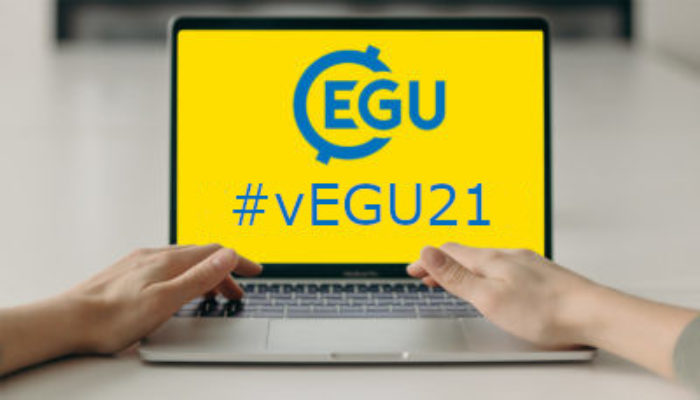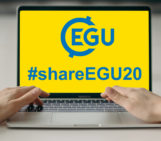
Abstracts, Displays and vPICOs: Upload, present and comment
At vEGU21, three elements compound all presentations, known as vPICOs: the “Abstract”, the “Display material” and the “Live presentation slide”.
Abstracts are the same as for in-person EGU General Assemblies. Each abstract submitted has received a DOI (Digital Object Identifier) to ensure the research is properly attributed and the researchers’ ownership of it is protected.
Display materials are a broad-range of long-form detailed material that authors upload to support their abstracts. Authors can add all the detail they want in the form of graphs, figures, links, powerpoint files and/or maps, with the limitation of 50Mb upload size in a large range of file formats, and 200 Mb for videos in .mp4. These videos can be pre-recorded oral presentations – just the same as real talks! In the case of video materials, they will be uploaded to the Vimeo channel dedicated to vEGU21 and only visible for conference participants. In addition, authors can provide a DOI or URL linking to a video submitted to a portal like YouTube. Authors can also provide a link to display material in .html format hosted on their own infrastructure. All displays are connected to the abstract and protected by the abstract DOI and can be seen essentially as pre-print information. Authors can also revise their displays as many times as they want. Attendees can comment on a display any time, since its upload until the end of May 2021. You can choose to submit your display materials under the Creative Commons Attribution 4.0 License (CC BY 4.0) or to restrict their reuse. Authors should clearly indicate this in their files (e.g., © Authors. All rights reserved). All display material submitted under the CC BY licence will be archived on EGUsphere after the end of May, while material with a different licence will be erased. According to the CC BY 4.0 License, a registered user may download display materials and share them as long as the authors are cited, whereas sharing is not allowed for materials on which rights are reserved.
Upon upload, authors can choose to allow comments and feedback on their display materials. Commenting is only enabled for meeting participants who are logged in with their Copernicus/EGU user IDs, and their names are disclosed. When someone comments on display materials, authors will receive an email notification so they can reply and start a dialogue. This option will be open until the end of May. You can also watch this basic walkthrough video to uploading and commenting.
The live presentation slide is a single slide that serves as a summary of your abstract. Authors present their presentation slide “live”, for 2 minutes, in their corresponding session. The live presentation slide can be unloaded any time until 24 hours before your scheduled session time. Make sure you can deliver your live slide easily and comprehensively in the 2-minutes time slot (summary talks will be automatically ended at the 2-minute mark!). If you cannot for whatever reason attend your live presentation, you may instead upload a 2 minute summary talk that will be played for you during your scheduled session time. You can either upload a slide (if you intend to present live) OR a video (if you do not intend to present live), but not both. The presentation slide will not be visible with your display materials and will not be saved or archived after your presentation.
Attendees preparing their live presentations and those that upload a pre-recorded video should ensure accessibility. This can be achieved by securing good close captions that will aid understanding by non-native English speakers and attendees with hearing disabilities. To further secure accessibility, all vEGU21 talks (Union Symposia, Great Debates and Union Medal Lectures) will have a live stenographer. Similarly, AI-based closed captioning for all other Medal and Award Lectures, as well as short courses, and all the 2 minute summary presentations will have google based closed captions.
To help the automated transcription software track your words and make good captions when you present, speak slowly and communicate clearly. This will lead to better understanding of your talk, anyway. This can be practiced with your live closed-captioner turned on. AI based closed captioning services are smart – they learn from you and your speech patterns – so the more you practice speaking into your live closed caption service, the more accurate it becomes, even for fairly complex scientific words. Presenters can try Powerpoint, Otter.ai, Google slides or Rev for live captioning. Be aware that mocking incorrect captions is a form of ableism, given that good captions are essential for many people to be able to participate in the discussions.
To create accessible images for talks and help others really connect with the main research ideas, presenters are encouraged to design their images carefully, and with the proportion of the audience that has a colour-vision deficiency in mind. Presenters can use test websites like Coblis to check favourable colour schemes. As a succinct guideline, avoid rainbow scales, which are inadequate for presenting and interpreting data, and difficult to be read in the first place, and use contrast and clarity wisely, with high contrast between text and background. Also, presenters should describe their images piece by piece, and explain its relevance, to maximize accessibility and effectiveness.
After the 2-minute “live” presentation of the abstract summaries, presenters will be split into individual text chat rooms to discuss their work with the interested audiences. Just like PICOs in previous meetings, the live presentation is aimed to be appealing to your audience and get people interested in your research, much like an elevator pitch, before the discussion is moved to the individual author’s text chat room, where details can be provided with the display materials uploaded.
To delve further, please check:
How to vEGU: uploading display materials, comments and the live presentation slide!,
vEGU21: Everything you need to know about displays, commenting & licencing
Accessibility at vEGU21: creating an accessible (and effective) presentation!
Relevant information for conveners
Conveners can interact with presenters either during their sessions, during the live vPICOs, in the breakout author text chats, and/or by commenting on the presenter’s display materials. We recommend conveners to get in contact with authors in advance to remind them to upload their live presentation slide, and other display materials, and let them know about the strict limitation on their 2-minutes presentations, as well as to prepare in advance by checking the display materials, and be familiar with the sequence of presenters and their topics. We encourage preparing some questions for the author text chats in advance. This is good practise and can help discussion in presenters individual chats with low or no audience. In any case, be aware of the 1-9-90 rule of online interaction (1% of people create, 9% interact, 90% lurk), so don’t worry if the number of people participating in a chat is generally low.
During the day of the session, it may be good to act just like in in-person sessions. Be sure to briefly mention the structure of the session, and the topics that will be discussed, and re-emphasise the idiosyncrasies of the vPICO: 2-minutes presentation and individual break-out chats thereafter. Encourage presenters to share information on how to reach them outside of the vPICO. Work with your Conference Assistant. They will facilitate your session, coordinating the live presentations with their corresponding vPICo slides and/or with pre-recorded videos, and will open the author text chat sessions. Let the discussion flow naturally in the main chat and individual chat rooms, but bring forward a discussion topic of general interest for attendants to your session to discuss in the main session room video chat that will remain open while the presenter’s chat continues. Make sure to be intolerant with abuses in any of the open chats. Together with other conveners and co-conveners, identify and deal with any abusive or disruptive behaviour (trolling, harassment and other points raised in the code of conduct, as stated above).
For more information, check: How to vEGU: Top 10 tips for promoting good online engagement for conveners
If you have a question that you can’t see answered anywhere else, please send it to us, either using our social media, or by contacting the conference organisers directly (egu21@copernicus.org).




